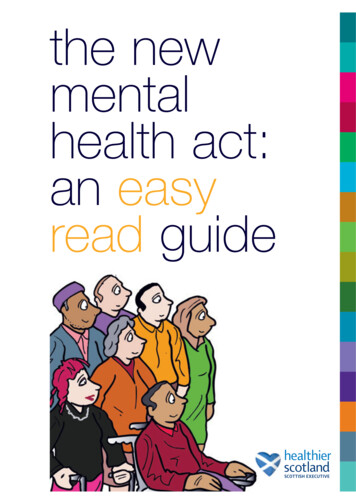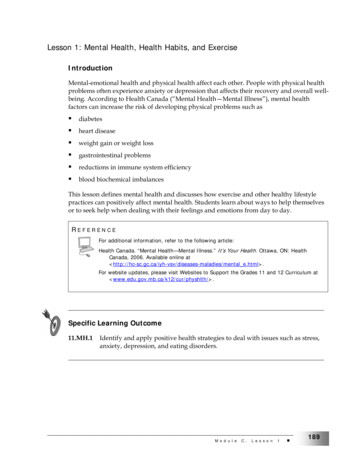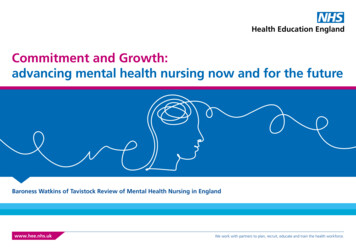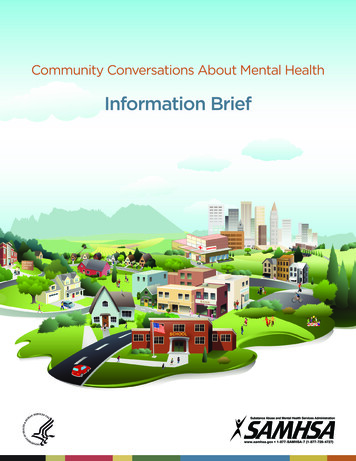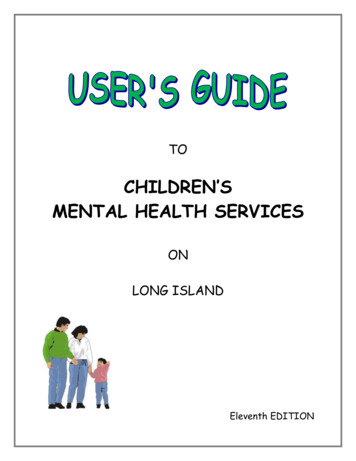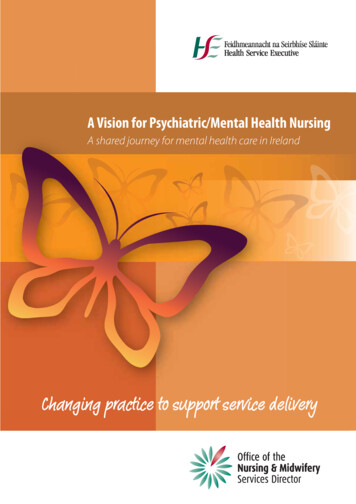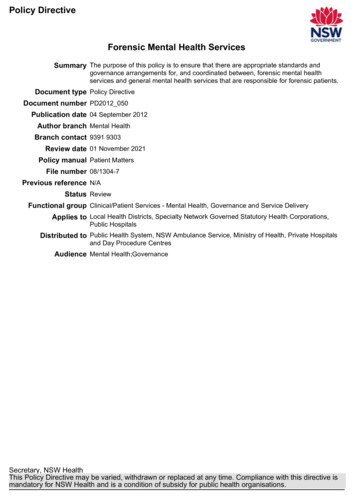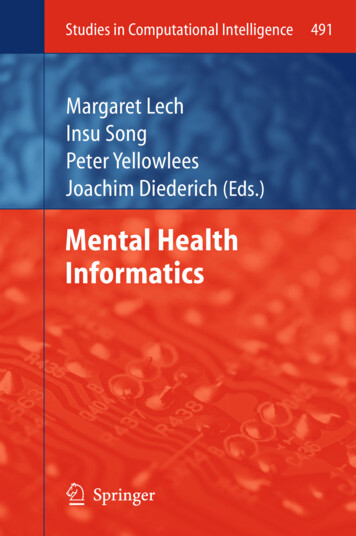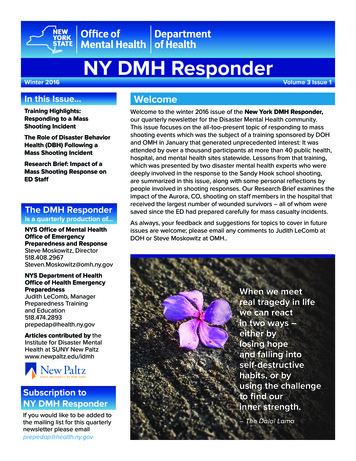
Transcription
DepartmentOffice ofMental Health of HealthWinter 2016NY DMH ResponderIn this Issue.Training Highlights:Responding to a MassShooting IncidentThe Role of Disaster BehaviorHealth (DBH) Following aMass Shooting IncidentResearch Brief: Impact of aMass Shooting Response onED StaffThe DMH Responderis a quarterly production of NYS Office of Mental HealthOffice of EmergencyPreparedness and ResponseSteve Moskowitz, Director518.408.2967Steven.Moskowitz@omh.ny.govNYS Department of HealthOffice of Health EmergencyPreparednessJudith LeComb, ManagerPreparedness Trainingand s contributed by theInstitute for Disaster MentalHealth at SUNY New Paltzwww.newpaltz.edu/idmhSubscription toNY DMH ResponderIf you would like to be added tothe mailing list for this quarterlynewsletter please emailprepedap@health.ny.govVolume 3 Issue 1WelcomeWelcome to the winter 2016 issue of the New York DMH Responder,our quarterly newsletter for the Disaster Mental Health community.This issue focuses on the all-too-present topic of responding to massshooting events which was the subject of a training sponsored by DOHand OMH in January that generated unprecedented interest: It wasattended by over a thousand participants at more than 40 public health,hospital, and mental health sites statewide. Lessons from that training,which was presented by two disaster mental health experts who weredeeply involved in the response to the Sandy Hook school shooting,are summarized in this issue, along with some personal reflections bypeople involved in shooting responses. Our Research Brief examines theimpact of the Aurora, CO, shooting on staff members in the hospital thatreceived the largest number of wounded survivors – all of whom weresaved since the ED had prepared carefully for mass casualty incidents.As always, your feedback and suggestions for topics to cover in futureissues are welcome; please email any comments to Judith LeComb atDOH or Steve Moskowitz at OMH.When we meetreal tragedy in lifewe can reactin two ways –either bylosing hopeand falling intoself-destructivehabits, or byusing the challengeto find ourinner strength.– The Dalai Lama
New York DMH Responder2Training Highlights: Responding to a Mass Shooting IncidentOn January 15, 2016, the Institutefor Disaster Mental Healthat SUNY New Paltz hostedthe annual DOH and OMHsponsored training webcastwhich focused on Respondingto a Mass Shooting Incident.The training was developedand presented by two expertswith extensive involvementin the response to the SandyHook School shooting as wellas other disasters. Kathy Dean,MSSW, is the Coordinator of theCenter for Trauma, Response,Recovery and Preparedness,where she’s responsible formaintaining the readinessof Connecticut’s DisasterBehavioral Health ResponseNetwork. She oversees statewidetraining initiatives to preparebehavioral health professionalsand preparedness partners fordisaster response and ensureseffective coordination with healthsystems preparedness partnersand traditional first responders.Jim Siemianowski, LICSW, isthe Director of Quality for theConnecticut Department ofMental Health and AddictionServices. Jim has served as thestate’s disaster mental healthcoordinator for the past 15 yearsand coordinated the state’smental health response andrecovery efforts after 9/11 andin recent natural disasters in thestate.Kathy and Jim’s presentationexamined both commonalitiesand contrasts with other typesof disasters so that DMHresponders state-wide can thinkabout how to adapt their previoustraining and response experienceto the specific characteristicsof this particularly intense kindof event. The training alsofeatured video vignettes withthree people who were involvedin the response to the 2009shooting at the American CivicAssociation immigration centerin Binghamton: Peggy Steinberg.ACSW, LSW, Director of SocialWork at Lourdes Hospital; AlanJ. Wilmarth, AdministrativeDirector, Behavioral Health atUHS Hospitals; and Raymond M.Serowik, NRP, Interim Directorof Emergency Medical ServicesCoordinator, Broome CountyOffice of Emergency Services.They addressed the impact ofthe event from the emergencyresponder and hospital staffperspectives.Key pointsfrom the trainingThese incidents are criminalacts so law enforcement plays amajor role in the response. Theirimmediate focus may need tobe on capturing the perpetratorand removing the threat ratherthan attending to the wounded.The site will need to be treatedas a crime scene and bodiesprocessed as evidence, whichcan delay the identificationprocess and release of remainsto families. And surviving victimsmay need to be interviewedas legal witnesses, potentiallyreawakening distressingmemories repeatedly.Media attention will be intense,especially initially, and reporterson-site are not likely to be verysensitive to survivor’s emotions.In the rush to get the story outquickly, inaccurate informationmay be disseminated. Exposureto reminders of the event throughmedia coverage has the potentialto retraumatize survivors andmedia depictions that focus onmental illness of perpetrators canincrease stigmatization amongthe general public.These events are oftenpoliticized, particularly regardingmental illness and gun controlpolicies. They also generatedifficult decisions related toallocating donated funds andplanning public memorials thatwill satisfy multiple constituentswho may have very differentneeds and preferences.
New York DMH ResponderSurvivors who were woundedmay face a lengthy recoveryprocess with lasting physicalproblems. Those who weren’twounded but who witnessedthe death or injury of others andbelieved they were in imminentdanger themselves are likely toexperience a shattered senseof safety, traumatic grief andanger and survivor guilt that theylived when others didn’t. Familymembers of victims and survivorsare also likely to struggle withanger and traumatic loss.Professional respondersand receivers face specificchallenges in fulfilling their dutiesin a mass shooting. For firstresponders the scene is likely tobe very chaotic, with extensiveexposure to dead and woundedpeople. Law enforcementprofessionals will need to ignorethe needs of the wounded untilit’s certain that the threat isover. If the perpetrator commitssuicide to avoid arrest theseprofessionals are deprived ofthe ability to fulfill their mission.Hospital-based first receiversneed to shift gears instantly toprepare to treat an unknownnumber of severely woundedpeople – sometimes only to learnthat there are few or no survivingvictims who they can actuallyhelp. And, importantly, if theevent is still unfolding it’s unclearwhether the shooter has beencaptured or killed, or there maybe multiple shooters involvedand these professionals must dotheir jobs knowing they may beat risk themselves.While these characteristics makemass shootings particularlychallenging for all involved,Kathy and Jim emphasizedthat the same principles thatunderlie all disaster mental healthinterventions do apply to theseevents. Specifically, they citedthe “Five Essential Elements ofImmediate and Mid-Term MassTrauma Intervention” outlined byHobfoll and colleagues in a 2007article in the journal Psychiatry: Promote sense of safety Promote calming Promote sense of self/collective efficacy Promote connectedness Promote hopeDMH responders need to thinkabout ways to adapt theseprinciples to the extreme postdisaster conditions a massshooting will produce. Forexample, responders can striveto provide a sense of physicaland psychological safety throughthese actions: Offer safe havens Provide routines andstructure Enforce security protocols Make necessaryenvironmentalaccommodations3 Recommend limitingconversations about theevent Recommend limitingexposure to media triggers Educate regarding evocativenature of triggers Offer opportunities for realitytesting Provide a child-safe area withassigned staffThey can try to promoteconnectedness – which isparticularly important after anact of intentional malevolencethat can shatter survivors’ trust inhumanity – in these ways: Reunite affected populationswith loved ones Offer space conducive toinformal interactions Offer formal opportunities forproviding information/hearingconcerns Convene groups, vigils,reunions, commemoratives Strengthen social supportskills Identify viable supportsystems Reconnect with pastsupports Establish new supports Underscore each individualjourney is uniquecontinued on page 6
New York DMH Responder4The Role of Disaster Behavior Health (DBH)Following a Mass Shooting IncidentAuthors:Jim Siemianowski, LICSW,Director of Quality Management, Connecticut Department of Mental Health and Addiction ServicesKathryn Dean, MSSW,Coordinator, Center for Trauma, Response, Recovery and Preparedness, Connecticut’s Disaster BehavioralHealth Response NetworkINTRODUCTIONMass shootings create specialchallenges for disaster behavioralhealth responders. While it isdifficult to reach agreement ona precise definition for massshootings, these are intentionalacts focused on killing or injuringas many people as possible.These tragedies are often ofshort duration and usually occurin a single location. They occurwithout warning, victims aretypically randomly selected,and survivors experience highdegrees of traumatic exposure.(Shultz et al., 2014)Uncertainty and chaos are majorcharacteristics of mass shootings,especially in the immediateresponse stage. The criminalnature of these shootings placeadditional stress on victimsbecause they are also witnessesto the event. The massive mediacoverage can re-traumatizevictims while shaping the world’sview of these events. The suddennature of these events alsomeans responders are unable topre-plan their response as theydo in many natural disasters.The response is complicatedbecause it often involves multipleresponders representing multiplejurisdictions, responding atmultiple community sites.Mass shootings can and doinvolve high degrees of traumaticexposure that may be linkedto long-term negative effects.However, it is important toremember that the degree ofexposure varies considerablyduring a mass shooting. Certainfactors like loss of a loved one,prior trauma, mental illness, andlack of social or familial supportsmay increase the risk for longterm psychological problemswhile other factors can help topromote resilience.loved ones. Victims will likely beinterviewed by law enforcementas they begin to conduct theirinvestigation. These actionscan begin within minutes of thefirst shots fired and continue forseveral hours.What follows include formaldeath notifications, funerals, andmemorials. After the immediatetragedy, victims may withdrawWhile mass shootings may seemoverwhelming to behavioralhealth responders, it is importantto recognize that we know agreat deal about trauma ingeneral and are learning agreat deal about responding tothese types of tragedies. Thisalready existing knowledge baseshould serve as a foundation forour disaster behavioral healthresponse efforts.CYCLES OF MASSSHOOTINGSMass shootings follow apredictable sequence of eventsthat at first may seem completelyout of control. Law enforcementsurrounds the scene intent onstopping the shooter(s) andsecuring the scene. Once itis confirmed the shooter isdisarmed, dead or no longer onsite, victims are evacuated fromthe shooting site. The woundedare transported to area hospitalsand survivors who were notwounded are moved to a sitewhere they can be reunited withand scatter as work or schoolis postponed while communityor business leaders strugglewith when and where to resumeoperations. Once that decisionis made this cycle continues aspeople return to work or schooland begin to attempt to return toprevious routines. This tragicallypredictable pattern highlightsdecision points that may requirebehavioral health input and alsosuggests intervention points.
New York DMH ResponderPOINTS OFINTERVENTIONA number of intervention pointsare obvious as victims andfamily members move throughthis cycle. DBH responders, ifthey can be quickly deployed,may be available to victims andtheir families at the reunificationcenter. They may also bedeployed to hospital receptioncenters when casualties arebeing transported to localhospitals and families are anxiousto learn about their loved one’scondition and their location.Disaster Behavioral Healthresponders will be present at afamily assistance center and arelikely to participate as part ofdeath notifications team involvedin formally notifying familiesthat one of their members hasdied. These teams may includelocal clergy or faith leaders, lawenforcement, and mental healthresponders.In the immediate aftermath,community drop-in centers maybe opened up as a way to assistthe community to grieve. Asvictims and survivors scatter orwithdraw, the family assistancecenter may remain open or beestablished to provide grievingfamilies an opportunity to besupported in a private setting,away from the public eye. Thecenter can provide informationto families about the range ofsupports that may be availableto them.Disaster Behavioral Health staffserving as liaisons may alsobe directly linked to survivingfamilies or victims as a wayto provide regular supportand monitoring until longerterm supports can be put inplace. During this period oftime the community may holdobservances or memorials wherebehavioral health supports maybe needed. When decisionsare made regarding resumingwork or school, DBH respondersmay be called upon to adviseand support this very difficulttransition period. Over time,businesses, schools, andthe community will require5longer-term behavioral healthinterventions to assist them in therecovery process.Disaster Behavioral Healthresponders are usually activeduring the immediate responseand early recovery efforts.This distinction is importantbecause immediate goals differsignificantly from behavioralhealth goals further into recovery.Early goals focus on triageand assessment of the mostimpacted, support for grievingfamilies and communities,linkages to resources andimmediate supports, and psychoeducation. While these earlyinterventions are always traumainformed, DBH responders in theimmediate and early recoveryphases would not be providingformal trauma treatment.The early response is heavilyinfluenced by the psychosocialimpacts of mass shootings. Massshootings produce catastrophiclosses on multiple levels: lossof life and loved ones, loss ofphysical capacities if somebodyis wounded, loss of a sense ofsafety, loss of the world as weknow it, loss of support systems,and the loss of routines andstructures that serve to anchor usin the world. In some instances,they may result in the actualloss of school or work setting asdecisions are made to resumeoperations in a new location.Mass shootings also result inhigh levels of individual andcommunity arousal, a feeling thatis palpable to those exposed tothe aftermath.continued on page 6
New York DMH ResponderTraining Highlights,continued from page 3Kathy and Jim also outlined someof the stressors DMH responderswill encounter in mass shootings,including high stress and longhours, unfamiliar circumstancesand coworkers, chaos in thework environment, uncertain andchanging work expectations,role confusion, and above all,exposure to intense distress inothers. This means that the needfor self-care is even strongerthan in other types of disasters,so it’s essential that all helpersplan and actually apply stressmanagement techniques thatwork for them.An archived version of thewebcast is available on DOH’sLearning Management Systemat https://www.nylearnsph.com.Search the course catalog forOHEP-DMHRec-2016 to findthe video.Resources for Dealingwith Violence and TraumaRecommended by Kathy Deanand Jim SiemianowskiNational Child TraumaticStress Network (NCTSN)www.nctsn.orgNCTSN Psychological First t-aidNational Center forPost-Traumatic Stress Disorderwww.ptsd.va.govCenter for the Study ofTraumatic Stresswww.cstsonline.orgSAMHSA Disaster TechnicalAssistance Centerhttp://www.samhsa.gov/dtac/6The Role of Disaster Behavior Health,continued from page 5ESSENTIAL ELEMENTSA framework described byHobfoll and a collection ofauthors provides guidance onhow to address these effects ofmass shootings. These authorsdescribed five essential elementsof immediate and mid-term masstrauma intervention. (Hobfollet al., 2007). While not focusedspecifically on mass shootings,these core elements provide anexcellent framework for earlydisaster response efforts. Whenone considers the effects massshootings have; shattered senseof safety, devastating loss,disruptions of social networks,high degrees of physiologicalarousal, it is understandablethat these actions can be usedto help promote recovery. Theelements are:Promote safetyPromote calmingPromote efficacyPromote connectednessPromote hopeSELF-CAREMass shootings can and dohave negative impacts on DBHresponders who will frequentlybe exposed to the pain of victimsand survivors as they struggleto deal with their losses. DBHresponders may learn abouthorrible details related tothe tragedy as survivors “telltheir stories”. DBH leadershipand responders are jointlyresponsible for ensuring thatDBH responders are not harmedby their participation in aresponse to a mass shooting.Before agreeing to respond,DBH team members should takestock of their current situation.For example, it is important toconsider if recently sufferedlosses or trauma or exposure toa similar trauma in the past willbe re-awakened by this type ofdeployment. It is also importantto take into account one’s currentphysical health and any medicalissues that would interfere withthe ability to safely respond orif current family or “life” issuesrequiring focus and attentionwould need to take priority. Uponmaking the decision to respond,it is important to carefullyconsider the components ofa personal self-care plan. Itis imperative that respondersremain mindful of the tools thathave sustained them throughstressful times or duringpersonal difficulties in the past.Responders must be deliberateand prepared to tap into theseself-care activities, even whenthey may not seem pleasurableor sustaining.CONCLUSIONDisaster Behavioral Healthresponders are challenged bymass shootings for a numberof reasons. The unexpected,catastrophic deaths, injuries,and the high degree of traumaticexposure can result in a responsethat is difficult to manage andcoordinate. The rapidly unfoldingnature of these disasters seemsto move at a dizzying pace. Itis important to recognize thateven in what appears to bechaos there is predictability anda growing knowledge base thatDBH responders can harness anduse to help promote recovery.
New York DMH Responder7Research Brief:Impact of a Mass Shooting Responseon ED StaffFollowing the mass shooting in a movie theater in Aurora, CO, inJuly 2012, the University of Colorado’s Anschutz Medical Campusreceived 23 wounded victims over about 30 minutes. One wasdeceased upon arrival; the remaining 22 survived thanks to theefforts of the emergency department staff who activated theirdisaster response plan in order to mobilize all available resources.According to Richard Zane, MD, FAAEM, chair of emergencymedicine at the University of Colorado School of Medicine, havingthose disaster plans in place and well-practiced was key to theED’s ability to handle the sudden influx of critically woundedpatients. Quoted in the Emergency Department Managementnewsletter, Zane said that balancing planning with flexibility isessential: “Although we prepare for disaster and mass-casualtycare you never prepare forspecific events becausepreparedness is 80%generic. and you have toaccept that the last 20% isgoing to be enigmatic orvariable.”Zane also noted impactof the intense responseon hospital staff whoconfronted this horrificevent in their owncommunity and the need for mental health support for personnel.Some staff members needed support immediately while othershad a delayed reaction several months later. Additionally, variationsin individual’s preferred type of support meant that hospitaladministrators needed to provide a variety of resources includingpeer support, spiritual care, grief counseling and access topsychologists and psychiatrists. Preferences for individual versusgroup support also varied. “The important thing is that you makethese resources available and that you publicize how to accessthem,” said Zane. “Create different types of venues and accessand be vigilant in making these resources available on an ongoingbasis.” Administrators should take note of these lessons in thepayoff resulting from dedication to preparedness – and the need forattention to post-response mental health support for staff memberswho perform heroically when they’re most needed, but who pay anemotional toll.SourceMass shooting in Colorado: practice drills, disaster preparations keyto successful emergency response. ED Management: The MonthlyUpdate On Emergency Department Management, 24 (2012), 109-12.Upcoming IDMHConference:Effective Response toMass TransportationDisastersThe 13th Annual Institutefor Disaster Mental Healthconference, “Effective Responseto Mass Transportation Disasters”will be held at SUNY New Paltzon April 15, 2016. Selectedkeynotes and workshops willfocus on traumatic loss and grief,the role of National TransportationSafety Board after transportationdisasters and the role of spiritualcare in supporting survivors.Sponsorship by the NYS Divisionof Homeland Security andEmergency Services will pay the 200 conference registrationfee for emergency managementprofessionals, first responders,mental health/psychologicalprofessionals, social workers/social services providers,health professionals, spiritualcare providers, members ofmedia, disaster volunteers, andacademic staff and students ofcertain disciplines. Please visitwww.newpaltz.edu/idmh for moreinformation about conferenceprogramming, and visit rainings/conference.html to register. Thenumber of DHSES-sponsoredseats is limited so please registerquickly if your role makes youeligible for one.
Immediate and Mid-Term Mass Trauma Intervention" outlined by Hobfoll and colleagues in a 2007 article in the journal Psychiatry: Promote sense of safety Promote calming Promote sense of self/ collective efficacy Promote connectedness Promote hope DMH responders need to think about ways to adapt these


